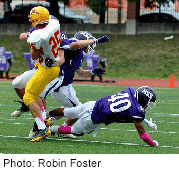
MONDAY, Oct. 28 (HealthDay News) — High-tech helmets and custom mouth guards do not reduce concussion risk for high school football players any more effectively than low-cost helmets or off-the-shelf mouth guards, a new study says.
Neither specific brands nor higher-cost protective gear resulted in fewer concussions among more than 1,300 football players at 36 high schools during the 2012 season, according to a study scheduled for presentation Monday at an American Academy of Pediatrics (AAP) meeting in Orlando, Fla.
“We’re certainly not saying that helmets and mouth guards aren’t important. They do what they are supposed to do. Mouth guards prevent dental injuries, and helmets prevent skull fractures and scalp and face lacerations,” said Dr. Margaret Alison Brooks, the study’s lead co-investigator. “But I don’t think the manufacturing companies have the data to support [the claim that] if a parent buys a specific model, their child will have a reduced risk of concussion.”
About 40,000 sports-related concussions occur in United States high schools every year, the researchers said.
Many manufacturers of football helmets and mouth guards cite laboratory research that their pricey equipment will better cushion impact and reduce players’ risk of concussion, said Brooks, an assistant professor of orthopedics and rehabilitation at the University of Wisconsin.
“We were interested in whether we can support the manufacturer claims that more expensive, newer, fancier football helmets really reduce the risk of concussion,” she said.
Players involved in the study completed a preseason questionnaire listing their personal statistics and previous injuries. Athletic trainers took notes on all concussions that occurred throughout the year.
The players wore helmets manufactured by three companies: Riddell (52 percent), Schutt (35 percent) and Xenith (13 percent). About 75 percent of helmets were relatively new, having been purchased since 2009.
The study also noted which mouth guards players wore. About 60 percent of players wore generic models provided by schools, while the rest wore models custom-fitted by dental professionals or specifically marketed to reduce the risk of concussions.
During the 2012 season, 115 players sustained a concussion — about 8.5 percent of all players in the study, the researchers said.
The concussion rate did not vary among players based on the type of helmet worn or the age of the helmet. The helmet brand also made no difference in the severity of concussions, which was measured by the number of days lost from play due to concussion.
“As long as the helmet their child is wearing is in good condition, is properly fit and is worn correctly, then the parent shouldn’t feel bad if their child is not in a $400 or $500 helmet,” Brooks said.
Players with custom-fitted mouth guards actually suffered a higher concussion rate than those who used generic models.
The realities of both physics and human anatomy make it unlikely that any helmet could better reduce the chances of concussion, Brooks said.
“There’s a lot of debate regarding whether you can create a helmet that could reduce concussion risk, given the structure of the skull,” she said. “The brain isn’t attached to the skull. It’s floating freely in spinal fluid. You can dissipate the force of something striking the skull, but you can’t reduce the forces that make the brain bounce back and forth inside the skull following impact.”
Because this study was presented at a medical meeting, the data and conclusions should be viewed as preliminary until published in a peer-reviewed journal.
Dr. Margot Putukian, director of athletic medicine at Princeton University, said the new study adds further evidence to the questionable ability of helmets to prevent concussions.
“I think the companies are well-meaning and they are trying to develop technology that might reduce impact, but we’re not seeing their efforts translate into a reduction in concussion,” said Putukian, who was not involved with the study. “There is risk in sports that can’t be completely negated by equipment.”
Coaches and officials would have a better chance of reducing concussions if they limited contact during practice and taught athletes the proper technique for tackling, study author Brooks said.
“I personally don’t have a problem with more emphasis on enforcing rules that limit contact with the head,” she said. “You shouldn’t be leading with your head. You shouldn’t be tackling with your head. We should be teaching kids that the head should not be the leading point of contact.”
On Sunday, the AAP released a new report with guidance for pediatricians caring for children and teens who suffer concussions.
The medical group outlined how long kids should stay home after concussions, depending on symptom severity, and recommended using a symptoms checklist. The AAP recommended a collaborative team approach, including the player’s pediatrician, family members and certain school staff members.
More information
For more about sports-related concussions, visit the U.S. Centers for Disease Control and Prevention.
Copyright © 2025 HealthDay. All rights reserved.

